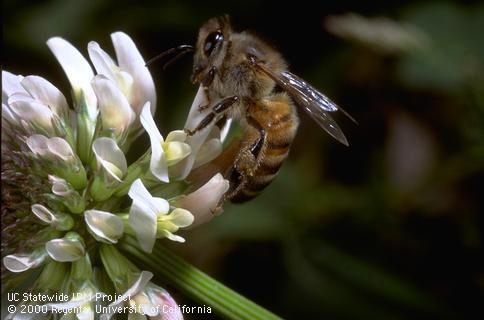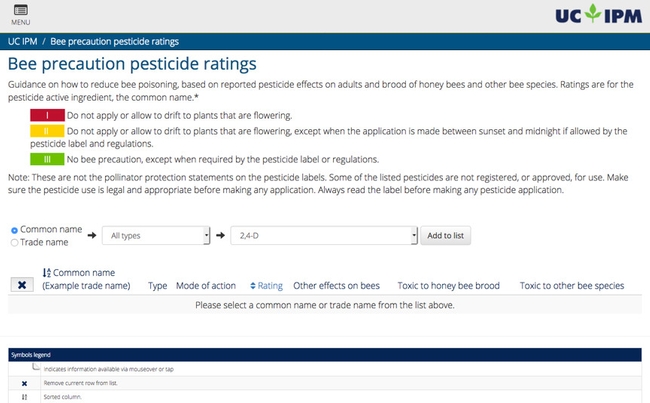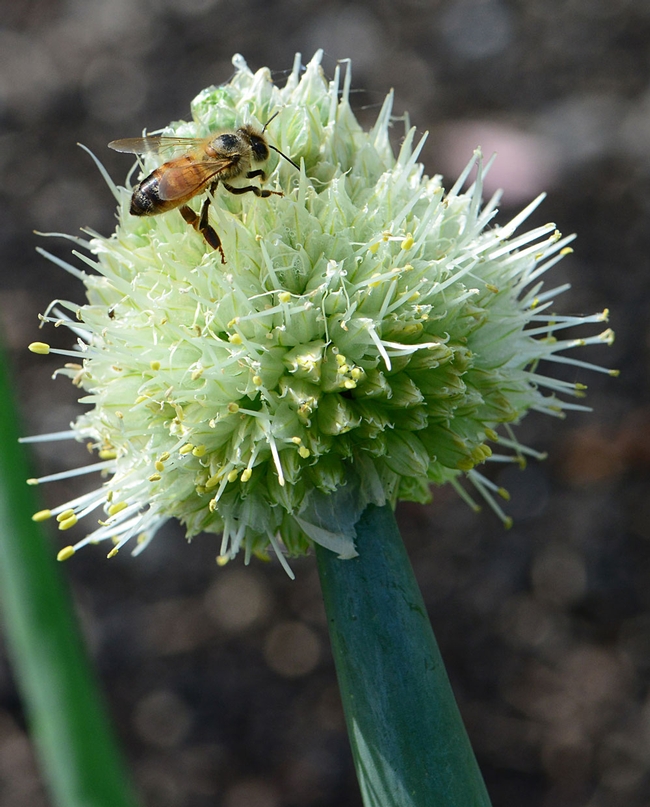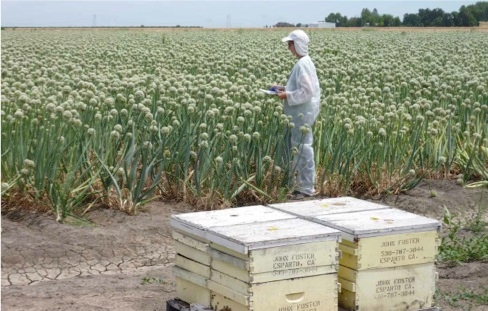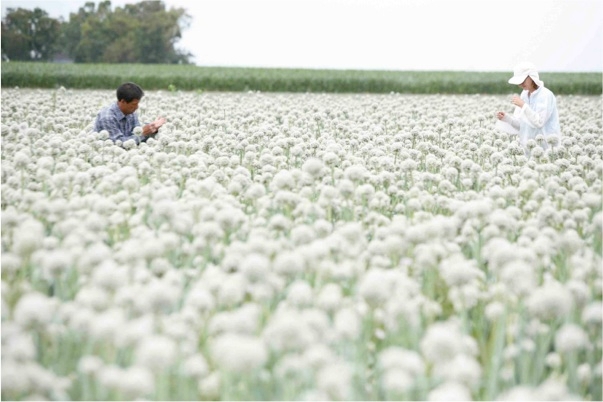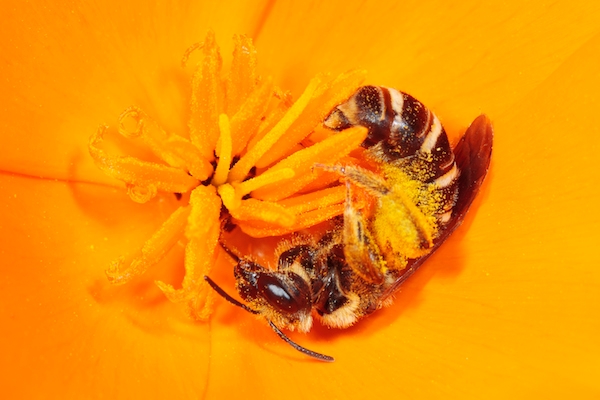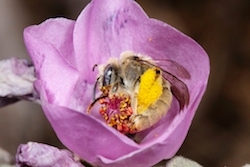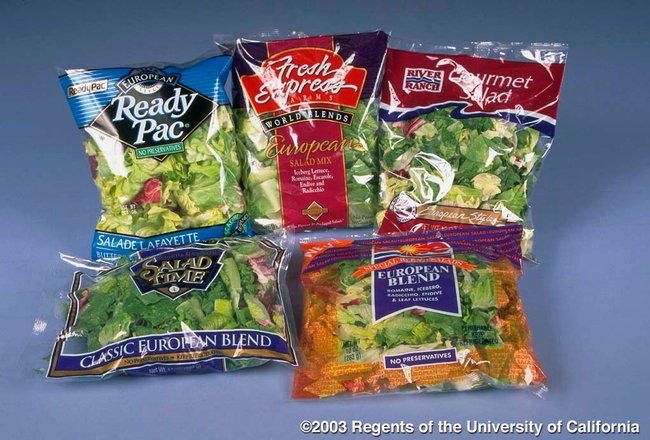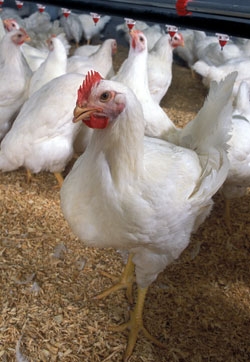Posts Tagged: honeybees
Protect bees from pesticides by using bee precaution ratings from UC IPM
Our mission at the University of California Agricultural and Natural Resources (UC ANR), Statewide Integrated Pest Management Program (UC IPM) is to protect the environment by reducing risks caused by pest management practices. UC IPM developed Bee Precaution Pesticide Ratings to help pest managers make an informed decision about how to protect bees when choosing or applying pesticides. You can find and compare ratings for pesticide active ingredients including acaricides (miticides), bactericides, fungicides, herbicides and insecticides, and select the one that poses the least harm to bees.
Ratings fall into three categories. Red, or rated I, pesticides should not be applied or allowed to drift to plants that are flowering. Plants include the crop AND nearby weeds. Yellow, or rated II, pesticides should not be applied or allowed to drift to plants that are flowering, except when the application is made between sunset and midnight if allowed by the pesticide label and regulations. Finally, green, or rated III, pesticides have no bee precautions, except when required by the pesticide label or regulations. Pesticide users must follow the product directions for handling and use and take at least the minimum precautions required by the pesticide label and regulations.
A group of bee experts in California, Oregon and Washington worked with UC IPM to develop the Bee Precaution Pesticide Ratings. They reviewed studies published in scientific journals and summary reports from European and United States pesticide regulatory agencies. While the protection statements on the pesticide labels were taken into account when determining the ratings, it is important to stress that UC IPM's ratings are not the pollinator protection statements on the pesticide labels. In a number of cases, the ratings suggest a more protective action than the pesticide label.
The UC IPM ratings also include active ingredients that may not be registered in your state; please follow local regulations. In California, the suggested use of the Bee Precaution Pesticide Ratings is in conjunction with UC Pest Management Guidelines (for commercial agriculture) and Pest Notes (for gardeners). Each crop in the UC Pest Management Guidelines has a link to the Bee Precaution Pesticide Ratings database and provides guidance on how to reduce bee poisoning from pesticides.
For more information on protecting bees from pesticides, see UC IPM's Protecting Natural Enemies and Pollinators, and use the Bee Precaution Pesticide Ratings.
Insecticide use threatens onion seed production
Insecticides farmers use in Northern California onion seed production appear to repel honeybees, which can result in reduced seed yields, according to a recent study by UC Agriculture and Natural Resources (UC ANR) researchers.
Visitation by honeybees is the single most important factor for onion seed set in commercial fields, said Rachael Long, UC ANR Cooperative Extension farm advisor in Yolo County.
“The more honeybees that visited the onion flowers, the higher the seed yield,” Long said.
If insecticides are applied repeatedly prior to onion bloom, honeybees were less likely to visit once the flowers opened up.
“If you spray three times in the spring before onion bloom, there was less honeybee activity during early bloom,” Long said. “We weren't sure why. We didn't see any dead bees. Honeybees might be repelled by the insecticide because, if a spray took place close to bloom, their visitation was significantly reduced, but increased later during bloom, as if the insecticide affects wore off.”
Yolo and Colusa county farmers play an important role in worldwide onion seed production. Many different varieties of onions are grown in the region to produce seed ideal for use on onion farms from Siberia to the equator and every latitude in between.
“Growing high quality onions in different areas around the world requires varieties specially adapted to a wide range of conditions, such as day length,” Long said. “In our region, you'll see a tremendous diversity of onions being grown for seed – some short, some tall, some bloom early, others later. There's also all the red, yellow and white bulb variations.”
George Weiss had been farming in Yolo County for more than 50 years when he noticed a mysterious decline in onion seed production in 2009. He paid a visit to the local UC ANR Cooperative Extension office.
“We grow onions for seed, and we weren't getting the seed yields we thought we should have,” said Weiss, 80.
He spoke with Long, who immediately began collecting information on insecticide use on the Weiss and neighboring farms.
“I saw a trend,” Long said. “The more insecticides that were sprayed, the lower the onion seed yield.”
Onion seed companies and officials at the California Garlic and Onion Research Advisory Board also observed lower yields.
“We all noticed a decline in seed production over the years, but we couldn't put a finger on what was happening,” said Bob Ehn, CEO of the California Garlic and Onion Research Advisory Board.
Long, Ehn and UC Davis entomology professor Neal Williams worked together to secure a $250,000 grant from the California Department of Food and Agriculture Specialty Crops Block Grant program to solve the onion seed mystery. Ehn's board also provided funding for research.
The sharp decline in onion seed yields began when growers were dealing with a new disease, iris yellow spot virus. The virus is spread by tiny insects called onion thrips, so growers began applying insecticides in early spring to keep the pests from moving the damaging disease around the field.
Over three years, scientists collected extensive data on insecticide use, honeybee activity, soil moisture, pollen germination, and nectar production on 29 onion seed farms of 25 acres of more. They learned that three applications of insecticide in the spring resulted in less honey bee visitation, which can reduce yield given the importance of honeybees in crop pollination.
The data analysis also concluded that:
- If farmers sprayed insecticides too close to bloom, there was less pollen germination. Typically, when a bee transfers pollen from the male to female flower, the pollen germinates right away and begins to grow, but less so after insecticide use. “There might be some chemical interaction that prevents pollen from germinating. It's not a huge effect, but there's an impact,” Long said.
- If the soil was too dry or too wet, nectar production in the onion flowers dropped way off, reducing honeybee activity and seed yields. “Honeybees need rewards,” Long said. “Their visitation to flowers is based on the ability to collect nectar. If there is little to no nectar, they will just bypass the flowers and find another source of nectar.”
- Fungicide use in onion fields did not impact honeybee activity.
- Pronounced effects of insecticides on pollinator behavior and seed set are more likely at rates of three sprays per year or more, however, even at reduced insecticide use, the researchers still saw the potential for subtle effects on both the pattern of honeybee visitation over time and the pollen-stigma interactions.
“These results highlight the importance of field management practices on the pollination process. In hybrid onion seed production, we recommend moderation in insecticide use and careful management of water during bloom for maximum nectar production,” Long said.
Ehn said the research furnished valuable information for California onion seed growers.
“We now know we have to be very careful about insecticide management prior to bloom time,” Ehn said. “We have to be more strategic about insecticide planning and avoid it as much as possible.”
Ehn said field research by Long, Williams and other UC ANR Cooperative Extension advisors and specialists is of critical importance to the California Garlic and Onion Research and Advisory Board.
“We are totally dependent on Cooperative Extension,” Ehn said. “Our research with Cooperative Extension stretches from Imperial County up to Tule Lake (on the Oregon border). They are our strength and anchor to get research work done that we set as a priority.”
Weiss said he highly values the research assistance from UC ANR Cooperative Extension.
“I can't pin it down in dollars and cents, but it all goes together with experience,” Weiss said.
An initiative to enhance competitive and sustainable food systems is part of UC Agriculture and Natural Resources Strategic Vision 2025.
A guide for California wanna-bees
The 1,600 species of wild bees that buzz their way to California gardens and green spaces get hungry, and there's a lot city dwellers and suburbanites can do to create an appealing buffet for the valuable pollinators. California Bees & Blooms: A Guide for Gardeners and Naturalists is a friendly new guidebook that shows readers how to make native bees thrive in an urban environment—and makes the case for why it's important to help them do so.
Home gardeners will want to post the chapter “Urban California's Best Bee Attractors” in their toolsheds for constant reference at planting time. Naturalists and other curious types wanting to identify and learn about the bees already visiting their gardens or communities can browse accessible chapters parsing the huge diversity of species. Educators will find general information useful for lessons for even the youngest of audiences, including who stings and why, where bees sleep at night, and who does the “waggle dance,” a “figure-eight shimmy” used for communication in hives.
With honeybee populations declining due to colony collapse disorder, the role of wild bees as pollinators is more important than ever — to everyone, not just large-scale farmers. The beautifully illustrated book, including stunning critter close-ups by photographer Rollin E. Coville, offers a wealth of information. In addition to expansive advice for growing and managing bee-friendly plants, the book even includes a section describing citizen science projects enthusiasts can participate in.
The book project is a University of California-grown collaboration. Co-authors are Gordon Frankie, a UC Berkeley professor of entomology; Robbin W. Thorp, a professor emeritus of entomology at UC Davis; Coville, an insect and spider photographer who received a Ph.D. in entomology from Berkeley; and Barbara Ertter, a curator at the UC Berkeley-based University and Jepson Herbaria.
The book is published by Heyday Books in collaboration with the California Native Plant Society.
Related
Foodie Bees: Insects Head Downtown for Dinner, National Geographic article.
Re-washing bagged greens may do more harm than good
Re-washing bagged greens may be making salads dirtier, according to a bevy of food safety experts, reported Deborah Schoch in the Los Angeles Times.
Even the cleanest kitchens can teem with harmful pathogens - on cutting boards and in salad spinners, on knives that just sliced raw chicken, on damp, well-used cloth towels.
"In brief, consumers don't wash up very well and may contaminate produce due to dirty hands and dirty sink," emailed Christine M. Bruhn, director of the Center for Consumer Research at UC Davis. That's especially a problem with salad greens, since they never get cooked.
Schoch spoke to food experts from Kansas State University and the University of Maryland who also recommended pre-washed greens not be re-washed.
California apprenticeship building future producers
Amy Trinidad, Sheep Industry News
The American Sheep Industry Association is teaming up with the state sheep associations to expand the Let’s Grow initiative to include mentor programs for beginning sheep producers.
“There is a real movement as far as people wanting to get back to the land. In some ways, it’s like the 1960s and 70s, only with a whole bunch of bigger challenges,” says Roger Ingram, University of California Cooperative Extension farm advisor.
Shepherds need to know how to run animals in a variety of environments, be able to identify common and uncommon pasture and range plants, know range nutrition, identify potential poisonous plants, be able to quickly asses the health of the flock and be able to take the appropriate steps in field conditions to fix problems, Ingram said.
Mild winter shifts the start of the growing season
Heather Hacking, Chico Enterprise Record
The lack of rain has meant some Butte County almond growers have already irrigated twice, and some are starting a third run with the water. They would rather not water at all, and often don't need to this time of year, said Joe Connell, UC Cooperative Extension farm advisor.
It can cost about $40 to apply 12 inches of water to one acre, he said. Growers will think carefully before pumping if it looks like another storm is on the way. The most recent rain provided water to the first foot of soil, depending on the soil conditions. But almond growers will want the soil irrigated 3 to 4 feet down by bloom time.
Almond trees in the area will likely begin to bloom around Valentine's Day this year, about a week earlier than normal.
Yuba-Sutter beekeepers abuzz on research
Jonathan Edwards, Orland Press Register
Losing bees to colony collapse disorder is not good for Yuba-Sutter. Beekeeping brought in about $3.9 million to area beekeepers in 2010, the last year for which data is available. On average, beekeepers have lost nearly one-third of their colonies each year since 2006.
That number likely skyrocketed last year as dwindling colonies drove higher prices. A shrinking supply of vibrant hives nearly doubled the price of a colony, from $33 to $58 between 2009 and 2010, according to the Sutter County Crop Report. The price nearly tripled again and is holding at about $150 a colony, said Eric Mussen, an apiculturist with UC Cooperative Extension at UC Davis.
"It just shot up," he added.
The price of chicken feed is rising
Soaring feed costs are forcing San Joaquin Valley poultry producers to cut costs, raise prices - and, in some cases, close their doors, reported Robert Rodriguez in the Fresno Bee this weekend. Feed prices have climbed as much as 50 percent since last year, fueled by the increasing demand for corn.
Director of the UC Agricultural Issues Center Daniel Sumner told the reporter that rising costs for poultry producers will boost the retail price, unless something else acts to keep prices down.
"So, bottom line," Sumner said, "we should see higher retail prices with these high grain and oilseed prices."
Ranchers beef over obstacles to local meat
Carlos Alcalá, Sacramento Bee
Small ranchers in El Dorado County gathered at a Local Meat Summit in Placerville last week to discuss obstacles to selling their products locally. Meat must be harvested at a USDA-approved facility, and there aren't many of those.
Program representative Sean Kriletich of UC Cooperative Extension in Amador and Calaveras counties is working with ranchers to solve the problem.
"We're trying to work toward getting a USDA-inspected facility for our region," Kriletich said.
If more small ranchers can find a way to sell grass-fed beef locally, it will do more than benefit the farmers, Kriletich said. It will preserve open space for the entire community.
"If people want to keep more land in agriculture, we have to get more money to the producers," said Kriletich, who said he used to run cattle himself, where El Dorado Hills subdivisions now sit.
Beekeepers asking Humboldt cities to loosen regulations on residential hives
Grant Scott-Goforth, The Willits News
A recent change in attitudes toward urban sustainability and education about bee culture spurred the Humboldt County Beekeepers Association to ask the cities of Arcata and Eureka to loosen restrictions on residential beekeeping.
UC Cooperative Extension farm advisor Deborah Giraud said the risks of keeping bees in residential areas are minimal. ”In general, it's really important to have more honeybees,” Giraud said. “We have a lot of problems with pollination here because of weather. Most calls in here are about fruit trees. And it's a pollination problem.”


